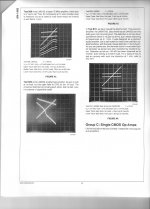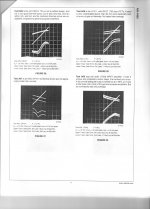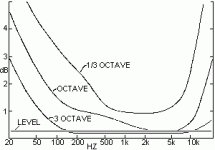Hi-end, to me, has taken the place of what was once termed "audiophile". What is fact is that some of JC's old timer's designs still outgun many State of the Art designs available today. This is because they make good music in any reasonable system and average listening environment. The same applies to Nelson Pass products along with those of a few other designers.
However, I suspect that - given a ready access at sensible cost to a plentiful supply of discrete devices - many of those involved in designing, making and marketing would swing toward today's integrated devices following production cost control exercises.
Military, industrial and non- (serious) audio applications are the prime marketplace for solid state technology. Sales made for pure audio applications - I am confident in saying - would be a tiny % of the runs of available devices; rather, devices used in top end audio would have been initially designed for other purposes. [Of course that remark applies equally to the older discrete devices.]
As this argument is likely to continue for as long as people care to post, I suggest that someone designs an amplification system based entirely on today's devices - with a limit of 5 years since product launch of those totally modern devices. When satisfied with a sample then perhaps a 'shoot-out' at a show!
However, I suspect that - given a ready access at sensible cost to a plentiful supply of discrete devices - many of those involved in designing, making and marketing would swing toward today's integrated devices following production cost control exercises.
Military, industrial and non- (serious) audio applications are the prime marketplace for solid state technology. Sales made for pure audio applications - I am confident in saying - would be a tiny % of the runs of available devices; rather, devices used in top end audio would have been initially designed for other purposes. [Of course that remark applies equally to the older discrete devices.]
As this argument is likely to continue for as long as people care to post, I suggest that someone designs an amplification system based entirely on today's devices - with a limit of 5 years since product launch of those totally modern devices. When satisfied with a sample then perhaps a 'shoot-out' at a show!
Now, looking at older IC's vs the mighty LM4562, we can see that the LM4562 is pretty good, BUT I have still found problems with it when it is loaded down excessively. I agree with PMA that virtually every NEW IC has its own personality profile, as that is what I have found with listening tests, so far.
Not being an EE or even understanding much of what is said on the technical side it is obvious that in John's world of extreme exclusivity and Ego things are not as they seem. I am not saying that John's designs do not sound great, just that much of what is written in magazines and reviews is BS at the minimum. When a reviewer is looking at the finish of the enclosure, or looking inside first to see if there are any opamps it is obvious that anything they say is suspect.
I can't imagine for a minute with the current sate of the art that thermal issues should be an issue with IC's when designed properly. What I see are designers designing heat-sinks for visual effect rather than for maximum thermal efficiency, or better yet hiding the heat-sinks internally inside a virtually closed enclosure so you don't have to see them!
If we are only talking about the puds who are showing off by purchasing 100K$ speaker systems with commercial drivers, or those who need a 1,000lb. flywheel to listen to a vinyl album let those people spend their money on a CTC type of product and great for those who can sell into that market, you are filling a need for those egotistical enough to spend the money.
But please stop insulting all the designer who don't want to use tubes or transistors that are no longer produced and can not be used in a commercial product.
John,
If you had another fire today and all your stock of unobtainable devices went up in smoke then what would you do? I bet you would get your *** in gear and figure out how to make a great sounding device with what is available today, and that would include newer transistors and IC's.
I can't imagine for a minute with the current sate of the art that thermal issues should be an issue with IC's when designed properly. What I see are designers designing heat-sinks for visual effect rather than for maximum thermal efficiency, or better yet hiding the heat-sinks internally inside a virtually closed enclosure so you don't have to see them!
If we are only talking about the puds who are showing off by purchasing 100K$ speaker systems with commercial drivers, or those who need a 1,000lb. flywheel to listen to a vinyl album let those people spend their money on a CTC type of product and great for those who can sell into that market, you are filling a need for those egotistical enough to spend the money.
But please stop insulting all the designer who don't want to use tubes or transistors that are no longer produced and can not be used in a commercial product.
John,
If you had another fire today and all your stock of unobtainable devices went up in smoke then what would you do? I bet you would get your *** in gear and figure out how to make a great sounding device with what is available today, and that would include newer transistors and IC's.
I lifted this from LME Answers posts
Bob Pease was able to hear the difference between the LME49710' and 713's in the sound room at National and was shocked that he could do that at 67 years old. We used identical D/A preamps for the listening tests. (I designed, and hand built, 10 of these as demo units to show off the LME parts and my Avatar is a pic of that preamp. Please check out the attached pic of an AP2 Cascade 192 THD+N plot of that preamp before and after a power supply change Bob Pease suggested. We actually presented that change to my LME base power supply regulator circuits at AES in SF several years ago.)
One unit had all metal can LME Opamps and the other one had all plastic dip LME Opamps. We matched the output levels of both D/A preamps to within 1dB and then sealed up the units and labeled them A and B. I then switched out the externally identical units and Bob listened to them in our sound room at National. (That sound room, which is closed up now, had Wilson Watt Puppies driven by the LME49811 power amps that I designed – See TI/National AP Note AN-1490 which is the LM4702 version of the same demo power amp. The LM4702 was the first part made on the new Vertical High Voltage process that made all the rest of the LME series of parts) Switching out the two identical units in this way resulted in a true double blind test... without having to use those poorly designed double blind switch boxes that always screw up double blind tests because they degrade the sound in the switch box.
When we were done with the listening tests we opened the units up to see if unit A or unit B had the cans or plastic parts the results were…(Insert suspenseful pause here) ..Bob chose the metal cans over the dips every time we did the test! (We did it twice as I recall.) Bob thought the metal can unit "Just Sounded Better" and was shocked that he could hear the difference. That led to some investigations about why...but Bob then had his terrible auto accident going to the wake for another IC industry legend Jim Williams and passed away before we got a chance to finish the tests.
(Analog engineering legend Bob Pease killed in car crash | EDN
Bob thought the reasons for the better sound with the metal cans might have been:
A. The plastic package is constraining to the layers of the chips which could cause problems with mechanical heat stress inside the die layers during thermal events...
B. The shielding of the can... (Only electrostatic though not magnetic which is usually a bigger problem)
C. The slightly larger round legs on the can
D. The thermal dissipation of the can
E. The exposed die mounted on a ceramic substrate inside the metal could handle the thermal transients "better"
F. Insert your guess here
But sadly we never got the chance to check out any of these possibilities together.
I hope some of you are enjoying listening to our LME Opamps! A ton of work (5+years), millions of $’s and some luck (and prayers) went into getting the LME series of parts produced.
Best LME Audio Regards,
Audioman54 / Mark
Attached Thumbnails
Bob Pease was able to hear the difference between the LME49710' and 713's in the sound room at National and was shocked that he could do that at 67 years old. We used identical D/A preamps for the listening tests. (I designed, and hand built, 10 of these as demo units to show off the LME parts and my Avatar is a pic of that preamp. Please check out the attached pic of an AP2 Cascade 192 THD+N plot of that preamp before and after a power supply change Bob Pease suggested. We actually presented that change to my LME base power supply regulator circuits at AES in SF several years ago.)
One unit had all metal can LME Opamps and the other one had all plastic dip LME Opamps. We matched the output levels of both D/A preamps to within 1dB and then sealed up the units and labeled them A and B. I then switched out the externally identical units and Bob listened to them in our sound room at National. (That sound room, which is closed up now, had Wilson Watt Puppies driven by the LME49811 power amps that I designed – See TI/National AP Note AN-1490 which is the LM4702 version of the same demo power amp. The LM4702 was the first part made on the new Vertical High Voltage process that made all the rest of the LME series of parts) Switching out the two identical units in this way resulted in a true double blind test... without having to use those poorly designed double blind switch boxes that always screw up double blind tests because they degrade the sound in the switch box.
When we were done with the listening tests we opened the units up to see if unit A or unit B had the cans or plastic parts the results were…(Insert suspenseful pause here) ..Bob chose the metal cans over the dips every time we did the test! (We did it twice as I recall.) Bob thought the metal can unit "Just Sounded Better" and was shocked that he could hear the difference. That led to some investigations about why...but Bob then had his terrible auto accident going to the wake for another IC industry legend Jim Williams and passed away before we got a chance to finish the tests.
(Analog engineering legend Bob Pease killed in car crash | EDN
Bob thought the reasons for the better sound with the metal cans might have been:
A. The plastic package is constraining to the layers of the chips which could cause problems with mechanical heat stress inside the die layers during thermal events...
B. The shielding of the can... (Only electrostatic though not magnetic which is usually a bigger problem)
C. The slightly larger round legs on the can
D. The thermal dissipation of the can
E. The exposed die mounted on a ceramic substrate inside the metal could handle the thermal transients "better"
F. Insert your guess here
But sadly we never got the chance to check out any of these possibilities together.
I hope some of you are enjoying listening to our LME Opamps! A ton of work (5+years), millions of $’s and some luck (and prayers) went into getting the LME series of parts produced.
Best LME Audio Regards,
Audioman54 / Mark
Attached Thumbnails
We matched the output levels of both D/A preamps to within 1dB...
BZZZT! Right there you see a huge problem- that's much larger than a just noticeable difference (~0.1-0.2dB, depending on listener and source material).
typo? - of course you can DBT "We matched the output levels of both D/A preamps to within 1dB "
0.1 dB is really the level match needed according to Clark's ABX tests
Clark, David L., "High-Resolution Subjective Testing Using a Double-Blind Comparator", Journal of the Audio Engineering Society, Vol. 30 No. 5, May 1982, pp. 330-338
ABX Amplitude vs. Frequency Matching Criteria
0.1 dB is really the level match needed according to Clark's ABX tests
Clark, David L., "High-Resolution Subjective Testing Using a Double-Blind Comparator", Journal of the Audio Engineering Society, Vol. 30 No. 5, May 1982, pp. 330-338
ABX Amplitude vs. Frequency Matching Criteria
Attachments
Audioman54 / Mark
Attached Thumbnails
Best not to read to much into hearsay and folklore based on what in the end was something to sell. I knew Bob for 35 years, you would not want to hear what he said about audiophiles, but then again that would be hearsay. I seriously doubt any blind controlled listening tests were done.
BTW controlling the temperature of the top surface of the package would not change any of those plots John posted. Unfortunately I no longer have a TEK op-amp curve tracer plug-in that functions or I could show you.
Last edited:
The same applies to Nelson Pass products along with those of a few other designers.
But Nelson at least honestly talks about the possibility of using the electronics for adding a little personal "flavor". There are not many other technical diciplines with that latitude.
adding a little personal "flavor".
Speaking of longitude, there's yachting.
And automobiles.
Ooh, wait, almost forgot cooking.
Eeer, howcome I fancy all four ?

but the IC's that I tested 40 years ago, looked like what the app note showed.
BIG DIFFERENCE!
The key is 40 years ago.
SHOW ME, SCOTT! PROVE IT!
You already have it in hand. Did you read the stuff you scanned and posted?
- Status
- Not open for further replies.
- Home
- Member Areas
- The Lounge
- John Curl's Blowtorch preamplifier part II


